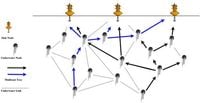The advent of Underwater Internet of Things (IoUT) networks marks a groundbreaking shift in how we explore and monitor the vast, often mysterious environments beneath our oceans and seas. These technologies, leveraging the capabilities of the broader Internet of Things (IoT), promise significant advances for applications ranging from environmental monitoring to resource exploration and disaster prediction. Despite their potential, IoUT networks grapple with unique challenges, including dynamic underwater conditions, high propagation delays, and unreliable communication channels.
To tackle these challenges, researchers have developed innovative solutions. A recent study published on March 18, 2025, by R. Mohammadi and colleagues proposes the integration of Software-Defined Networking (SDN) with Fog Computing to bolster the reliability of underwater communications. This novel approach utilizes Integer Linear Programming (ILP) models to optimize multicast routing operations between underwater nodes and surface-level nodes.
Underwater environments are inherently varied and unpredictable, influenced by factors such as water currents, salinity, and temperature fluctuations. These variables complicate the communication efforts of IoUT networks, which are already hindered by low bandwidth and high bit error rates. Communication paths often suffer delays, as sound travels at approximately 1500 meters per second underwater. To alleviate these issues, the research team has developed a multicast routing tree aimed at minimizing delays and maximizing the reliability of data delivery.
"By leveraging Fog computing and SDN, we are addressing the unique challenges of underwater communication effectively," wrote the authors of the article. The proposed architecture not only optimizes communication paths but also allows for dynamic network adjustments, enhancing the adaptability of the system as conditions change.
The methodology integrates SDN’s centralized control capabilities with Fog Computing, providing network resources closer to the IoUT nodes. This combination reduces latency inherent to conventional cloud infrastructures, enabling real-time data processing and decision-making directly at the edge of the network.
Simulation setups were conducted within three-dimensional underwater environments measuring 1000 m x 1000 m x 1000 m, where various scenarios were analyzed. Each underwater node periodically reported its location and energy levels, allowing for the establishment of the multicast routing tree based on up-to-date information about node viability. The traffic among nodes was modeled using Poisson distribution, which is common for network communications.
The results from these simulations illustrated significant advancements. Notably, the proposed multicast method yielded lower packet loss rates compared to traditional hop-count routing methods. While the multicast approach did incur higher energy consumption—which is expected due to the need for multiple packet distributions—it substantially outperformed standard techniques in terms of network reliability and lifetime.
"Simulation results confirm our method enhances performance and reliability significantly," affirmed the authors of the article. With increased efficiency, the proposed architecture ensures effective data collection and analysis, maintaining operational continuity even under challenging conditions.
Although the multicast routing method tends to consume more energy overall, the longer network lifetime and reduced probability of packet loss present persuasive benefits. This work paves the way for more reliable underwater communications, with potential applications spanning environmental monitoring to military uses.
Overall, by leveraging cutting-edge SDN and Fog Computing technologies, this research not only presents solutions for immediate challenges but also opens avenues for future explorations of underwater environments. Further investigations could lead to even more advanced techniques, enhancing the effectiveness of IoUT networks and ensuring they can meet the pressing needs of their diverse applications.

